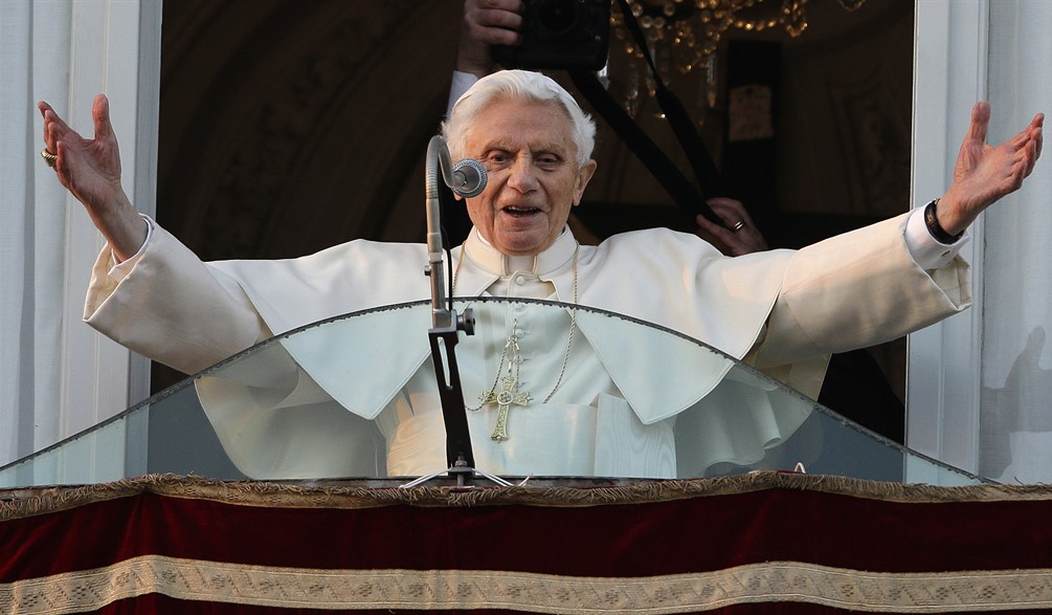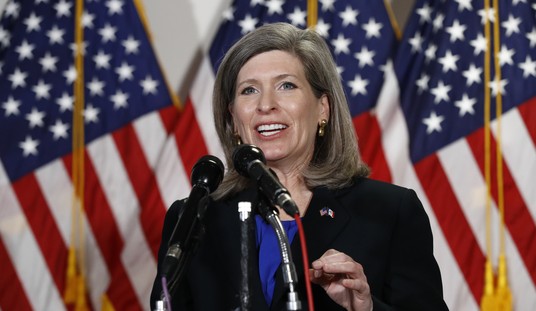The modern two-pope era drew to a close this morning at the Mater Ecclesiae Monastery. Pope Emeritus Benedict XVI, born Joseph Aloisius Ratzinger and who went on to an impressive career as a post-Vatican II theologian before ascending to the chair of Peter, died early this morning. Three days ago, Pope Francis had asked the faithful to pray for his predecessor “until the end,” which came just as the year draws to a close:
The Vatican has confirmed that retired Pope Benedict XVI, who made waves throughout the Catholic world with his historic resignation in 2013, died Saturday morning at his residence at the age of 95.
Vatican spokesman Matteo Bruni communicated the news in a statement, saying, “With sorrow I inform you that the Pope Emeritus, Benedict XVI, passed away today at 9:34 in the Mater Ecclesiae Monastery in the Vatican. Further information will be provided as soon as possible.”
The funeral has already been scheduled for Thursday, January 5th, enough time to allow bishops to travel to Rome for the event. The Vatican press office has also announced that Pope Francis will preside over the funeral Mass, likely with a number of concelebrants. However, the Holy See also said they expect the funeral to be “sober, simple, and solemn,” which seems a more proper fit for the sober and solemn Benedict.
Most news outlets, including Catholic media organizations, properly lead with the fact that Benedict turned tradition on its ear by being the first pope in 600 years to retire. The irony of a traditionalist like Benedict innovating to that extent is certainly worth noting, as is the irony that Benedict’s tenure as Pope Emeritus lasted longer than his tenure as pope. Benedict served in the latter role for just under eight years (April 2005 – February 2013), while he only just missed his ten-year anniversary of his emeritus status.
Veteran Vaticanista John L. Allen Jr remembers Benedict as “the pope of ironies,” and perhaps one of the most unlucky of pontiffs:
From a strictly PR point of view, Benedict may have been the unluckiest man to take over leadership of the Catholic Church in centuries. Sandwiched between two celebrity popes in John Paul II and Francis, the shy and cerebral Benedict was perhaps always destined to be under-appreciated.
With the benefit of hindsight, Benedict XVI now seems a towering “Pope of Ironies,” with three in particular standing out.
For most of his career, the theologian and prelate who became Benedict XVI had been seen as the great “Doctor No” of the Catholic Church from his perch as the Vatican’s doctrinal czar. There was no controversy in Catholicism for a quarter-century in which then-Cardinal Joseph Ratzinger didn’t play a leading role, usually as the disciplinarian taking wayward theologians to task.
Yet once he became pope, Benedict pioneered “Affirmative Orthodoxy,” meaning the most upbeat and positive presentation possible of classic Catholic teaching. The idea was to emphasize the Catholic “yes,” rather than the church’s traditional catalogue of “no’s.”
Also ironically, his passing may finally give Benedict his due as a reformer:
In addition, Benedict was little invested in management by temperament or training, having once openly confessed that “I don’t have the charism of governance.” He paid a steep price, not least with the surreal “Vatican leaks” affair that marred the latter stages of his papacy and, in the eyes of some observers, propelled Benedict towards resignation.
Yet in a second grand irony, this non-manager also launched historic management reforms on two key sources of scandal for Catholicism, child sexual abuse and the Vatican’s decidedly mixed record on money. He was the first pope to embrace a “zero tolerance” policy on abuse, and the first to open the Vatican to outside secular inspection of its accounts.
Benedict faced down strong internal opposition to do so, and by the end of his reign officials opposed to reform on either front had been driven largely underground. Though incomplete at the time his papacy ended, both these house-cleaning operations have been carried forward under Pope Francis.
Add to that the extensive and accomplished theological career that preceded Benedict’s pontificate. Also sometimes overshadowed by his work at the Congregation for the Defense of Faith for 23 years, Benedict XVI was a deep thinker and essayist on Christian faith and morals. Francis X. Rocca recalls that career in his overview of Benedict’s life at the Wall Street Journal:
In his roles as a prolific writer on theology, the Vatican’s top doctrinal official and eventually as the head of the church, Benedict argued for the compatibility of a transcendent faith in Jesus Christ with human reason, and for the continuity with tradition of the modernizing changes in the church that followed the Second Vatican Council of 1962-65.
As Father Joseph Ratzinger, he served as an influential adviser during Vatican II, as the council is known, and his death now removes the last major theologian associated with that pivotal event in 20th-century church history. But he later became a critic of progressives who, he said, had misinterpreted the council as a break with past doctrine and practice.
Respect for his theological works went beyond Catholic boundaries:
Archbishop Justin Welby of Canterbury, spiritual leader of the Anglican Communion, said: “Pope Benedict was one of the greatest theologians of his age—committed to the faith of the Church and stalwart in its defense.” Archbishop Welby said of Benedict’s historic resignation: “In making this choice freely he acknowledged the human frailty that affects us all.”
Popular history consigns Benedict to the abuse scandals and Francis to the reforms of it, but that is not accurate, Rocca reminds us. The reforms — including papal engagement with victims and streamlining process for punishment and defrocking — started with Benedict:
Before becoming pope, Cardinal Ratzinger oversaw the Vatican’s disciplining of clergy who sexually abused minors for more than two decades, pushing successfully for church law to make it easier to punish and remove abuser priests. As pope, Benedict extended the statute of limitations for the abuse of minors. By contrast with John Paul, who never met with abuse victims, Benedict met several times with groups of victims during his travels, including to the U.S. in 2008.
A “pope of ironies” is not at all a bad description of Benedict XVI. That may not have played in his favor before now, but perhaps will help in assessing his legacy now that Benedict has gone to the Lord.
What of the two-pope Catholic Church? We may still see papal retirements in the future, but Benedict XVI will likely be the last “Pope Emeritus.” Francis has already called for more rules to explicitly define the roles of retired popes; Rocca notes that Francis has suggested that “Bishop Emeritus of Rome” would be a better choice. While Benedict lived, such regulation and changes would have looked unseemly, especially since Benedict remained committed to staying out of Francis’ way. The risks of such an arrangement still remained evident, however, and the church now has an opportunity to formalize a process for such decisions.
In my view, Benedict XVI had a more profound and impactful pontificate than has been generally thought, especially by media organizations largely hostile to traditional Catholicism. Those same media organizations played up differences between Francis and his two predecessors for their own purposes, but in reality, we have mainly had theological continuity between the three pontificates. The approaches and styles have been different, especially Benedict’s more modest and introverted approach to public relations. However, in the long run, we are likely to appreciate Benedict’s role as a theological bulwark that allowed for a more pastoral approach by his successor, a pontiff that strengthened the best part of St. John Paul the Great’s reign while beginning the necessary repairs to keep the Church on its mission.
Requiescat in pace, Benedict XVI, and thank you. I’ll be praying for you, and hope you will be praying for me as well.
Addendum: Just as an aside, I’d recommend that readers spend more time reading media outlets with real knowledge and insight into the Catholic Church and the Vatican regarding Benedict XVI’s passing and his legacy. Francis Rocca at the WSJ and John Allen and Crux are good places to bookmark, but if you want more breadth and variety, try America Magazine, National Catholic Register, National Catholic Reporter, The Pillar, and even L’Osservatore Romano, an Italian-language newspaper translated into English.







Join the conversation as a VIP Member